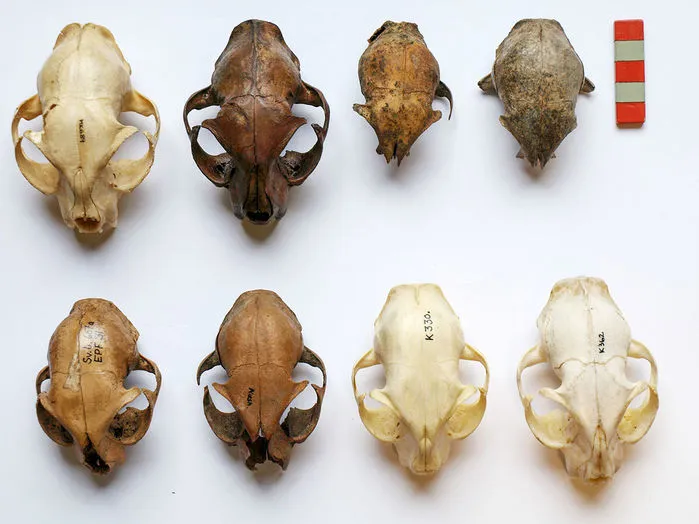Cats Have Actually Grown Larger Over Time—Unlike Most Domesticated Species
Between the Viking Age and modern times, felines increased in size by 16 percent
/https://tf-cmsv2-smithsonianmag-media.s3.amazonaws.com/filer/56/4a/564a542d-5c37-4be7-8892-98201ab13180/cat-2083492_1280.jpg)
During the Viking Age, domesticated cats were popular companions prized for their pest control abilities—and, in a dark turn of events, their pelts, which the Norse seafarers often donned as clothing. The idea of feline fur fashion may sound disturbing today, but as Emily Underwood reports for Science magazine, the practice yielded a bevy of ancient cat skeletons that have actually enabled modern scientists to better understand the long history of human-cat relations.
Perhaps the most surprising find detailed in a new Danish Journal of Archaeology study is the domesticated feline’s growth over time. Although most animals tend to shrink as they become domesticated (the average dog, for example, is around 25 percent smaller than its wild relative, the gray wolf), Julie Bitz-Thorsen of the Arctic University of Norway and Anne Birgitte Gotfredsen of the University of Copenhagen recorded a 16 percent jump in size between Viking Age and contemporary cats.
The reasons for this hefty increase remain unclear, but according to the study, plausible explanations include greater food availability—in the form of either human waste or a higher rate of deliberate feedings—and the shift in culture from treating cats as “fur providing and rodent catching” animals to “the present-day pet invited indoor, fed and cared for.”
To assess the differences between ancient cats and those of today, Bitz-Thorsen, then an undergraduate at the University of Copenhagen, extracted cat skulls, femurs, tibas and miscellaneous bones from dozens of bags filled with a mixture of dog, horse, cow and cat remains discovered at archaeological sites across Denmark. The samples dated from the late Bronze Age to the 1600s, with many originating in Viking era mass graves filled with the carcasses of hapless, de-furred cats.
“You can tell the cats were skinned,” Bitz-Thorsen tells Science’s Underwood. “They have cut marks, or the neck has been broken.”

Researchers have long puzzled over the exact timeline of cat domestication, but a 2017 study published in Nature Ecology & Evolution posited that the ancestors of today’s house cats arrived in two distinct waves. The first of these early felines likely spread from southwest Asia into Europe and the Middle East as early as 4400 B.C., Casey Smith writes for National Geographic. This lineage was based in the Fertile Crescent, otherwise known as the birthplace of agriculture, and includes a 9,500-year-old Cyprus cat buried alongside its human.
The second set of felines consisted of an Egyptian lineage that spread across Africa and Eurasia as early as 1700 B.C. but didn’t truly accelerate until the fifth through 13th centuries. According to Karin Brulliard of The Washington Post, Viking cats belonged to this lineage; remains found at a Viking trading port on the Baltic Sea support the idea that tabbies were employed as pest control on Middle Age ships.
Interestingly, Abigail Tucker, author of The Lion in the Living Room: How Cats Tamed Us and Took Over the World, tells The Cut’s Alice Robb that felines are “uniquely ill-suited for domestication.” In addition to demanding a diet of “fancy food,” cats are solitary creatures lacking social hierarchies, making them difficult for humans to control. Still, cats have one advantage above ostensibly similarly unfriendly wild animals such as badgers and foxes: Their facial features remind us of human infants, enabling them to become “an intriguing and charming presence, rather than a straight-up nuisance, like a raccoon.”
Regardless of whether early felines won over humans with their cherubic charm or deadly hunting skills, Bitz-Thorsen tells Science that by the late Middle Ages, cats had become the treasured, well-fed house pets they remain to this day.
Domestication enabled cats to reduce the level of energy expended on finding food, but University of Oslo cat domestication expert Claudio Ottoni explains to Science that it’s unclear whether a change in diet or an actual genetic shift triggered the animals’ jump in size. To answer this question, Ottoni says researchers will need to search ancient cat DNA for chemical signatures of a changing diet.
/https://tf-cmsv2-smithsonianmag-media.s3.amazonaws.com/accounts/headshot/mellon.png)
/https://tf-cmsv2-smithsonianmag-media.s3.amazonaws.com/accounts/headshot/mellon.png)